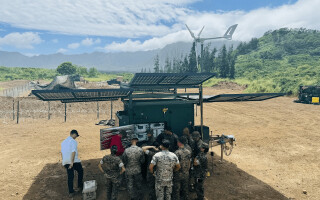MOSA reaffirmed, empowering small business
BlogFebruary 27, 2025

Fans of the U.S. Department of Defense’s (DoD’s) modular open systems approach (MOSA) mandate got a nice surprise before the December holiday season: a new Tri-Service memo emphasizing continued support for MOSA, well-timed with new DoD leadership coming in focused on reforming acquisition.
The first MOSA Tri-Service memo, published in 2019, mandated that all new programs and tech refreshes must leverage MOSA. The latest memo – signed by the Secretaries of the Army, Navy, and Air Force on December 17, 2024 – states that “MOSA shall be implemented and promulgated among the military services to facilitate rapid transition and sharing of advanced warfighting capability to keep pace with the dynamic warfighting threat.”
Simply put, they see MOSA a way to get technology more quickly into the hands of the warfighter, as a tool for speeding up acquisition. Successful MOSA examples were called out in the memo: the Sensor Open Systems Architecture, or SOSA, Technical Standard; Weapons Open Systems Architecture (WOSA); and others.
For a MOSA example, see Lockheed Martin’s announcement last year, that it will develop a low size, weight, and power (SWaP), SOSA aligned airborne electronic defense system, leveraging Multi-Chip Package (MCP2) from Altera, an Intel company, for expected use on the U.S. Navy’s MH-60R multi-mission helicopter. (Pictured)
The memo also lists the three new MOSA sections added by Congress to Title 10 of the United States Code (USC):
- “Section 4401 requires MOSA in major defense acquisition programs [MDAPs],
- Section 4402 requires the implementation of MOSA in program capability development and acquisition weapon system design, to include verification of MOSA requirements, and
- Section 4403 relates to ensuring the availability of major system interface standards and support for MOSA in defense acquisition.”
The service leaders went on to direct that all DoD acquisition officers commit to “all five MOSA pillars: (1) employing a modular design, (2) designating modular interfaces, (3) leveraging consensus-based open standards, (4) establishing enabling environments, and (5) certifying conformance.” To read the memo, visit https://tinyurl.com/y3cced9y.
MOSA initiatives are having an impact as seen by increased requirements for items like SOSA aligned products. However, enthusiasm and mandates cannot change the laws of bureaucratic physics – governments move slow, not fast. MOSA strategies are long-term plays, but faster procurement and acquisition reforms are being called for by the new Trump administration and its supporters.
“Procurement is a mess, and given that the Pentagon purchases more goods, services, and software than all other federal agencies combined, this is a huge crisis,” write Joe Lonsdale, co-founder of Palantir, and his colleague John Noonan in a blog titled “America Needs Better Defense Acquisition.” Read it here: https://blog.joelonsdale.com/p/america-needs-better-defense-acquisition.
They say the new administration “can seize the moment, learn from what worked and didn’t work in [Trump’s] first administration, and make generational changes to our defense bureaucracy.”
Lonsdale and Noonan write that trimming down the “Federal Acquisition Regulation (FAR), first issued on April 1, 1984,” is a good place for the new administration to start. “The [FAR] has almost doubled in length, and with it the complexity of the overall federal procurement processes – not just the Defense Department,” they state. “The FAR was written to level the playing for all companies, big and small, who sought government contracts. But as with many federal regulations, the cure was worse than the symptoms, and it favored the biggest companies with the highest proportion of lawyers.”
The authors also call Foreign Military Sales (FMS) approval a “suffocating” process that favors the big defense companies, blocking out new innovative companies.
Innovation is needed, as are more organizations like the Defense Innovation Unit (DIU), which we’ve covered in this space before, around their work integrating commercial uncrewed tech into the defense space and Lonsdale and Noonan tout as an effective acquisition solution.
They also discuss the aforementioned Title 10, saying it has “become swollen with obsolete and choking legal requirements. This creates fertile grounds for long and contentious lawfare when bids don’t go a company’s way, dragging out deployment of new weapons by years. And because it is so difficult for little companies and startups to bring on the lawyers and lobbyists and staff to contend with this dizzying array of red tape, the government must set aside billions in small business contracts just to give them a shot. Small business is the backbone of our country, but welfare does not get the taxpayer the best value for his money.”
They’re absolutely right. However, the participation of small-business electronics suppliers in MOSA initiatives like the SOSA Consortium hint that the new MOSA additions to Title 10 may actually empower small business. We’ll see.
For more on acquisition reform and technology Lonsdale is worth reading and listening to – he’s often a guest on CNBC’s SquawkBox – and is a good follow on Twitter (@JTLonsdale).





